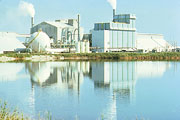
Since 1965, PCS Phosphate (White Springs, FL) - also known as White Springs Agricultural Chemicals, Inc. (WSA) - has been a successful phosphate mining company and producer of phosphoric acid-based compounds used in the manufacture of liquid and granular fertilizers as well as animal feed supplements. The plant employs approximately 1,200 people and anchors the economy in northern Florida's Hamilton County.
PCS Phosphate's White Springs plant mines phosphate rock, produces phosphoric acid, and combines the acid and aqueous ammonia for annual production of over 700,000 tons of diammonium phosphate (DAP), an ingredient in fertilizer blends. PCS Phosphate's products are shipped to major markets throughout the world.
Prior to mixing, phosphoric acid and ammonia are stored in separate vessels. Ammonia requires a constant temperature of 40°F to maintain its pressure below the design parameters of the storage spheres. This presents a significant challenge, since humidity levels frequently reach 100% in Florida, along with 100°F temperatures. To ensure that the ammonia is stored at the proper temperature in two 2,000-ton spheres, each sphere must have an insulation system that provides constant thermal efficiency and is impermeable to the destructive effects of moisture.
The Past Is Prologue
The company's risk management department originally specified Foamglas® insulation for the ammonia spheres when they were first installed by Petrin Corporation (Port Allen, LA) for a previous operator in the 1960s and 1970s. This time around, the facility's management saw no reason to change course. "We wanted a long-lasting product that wouldn't be damaged by moisture," said Petrin's John Haefner. "The original insulation on the ammonia sphere held up really well for over 20 years. That says a lot when you consider the high humidity and amount of rain Florida gets."The original mastic coating on the sphere was affected by weather years ago, leaving the Foamglas insulation to stand alone in some areas. But the insulation provides the perfect defense against heavy rainfalls and high humidity since it is impermeable to moisture in both liquid and vapor forms and retains its thermal insulating properties throughout its long service life.
This is critical since moisture absorption, even in small amounts, is a leading cause of insulation failure. If a permeable insulation absorbs just 4% moisture, it can lose 70% of its thermal efficiency. Even when a mastic sealant is applied over the insulation as a moisture barrier, a permeable insulation can absorb a significant amount of moisture from extreme humidity or precipitation, even prior to its installation.
The Installation
"The weather really played havoc while the insulation was being installed," Haefner said. "There was a lot of rain and high relative humidity - perfect conditions for insulation damage."Nevertheless, the insulation was bonded directly to the sphere with Pittsburgh Corning's (Pittsburgh) flexible PC® 88 adhesive to keep any rain from penetrating between the insulation and the sphere, significantly reducing the possibility of future corrosion.
In addition to impermeability and resistance to moisture, project specifications for the retrofit required a non-flammable insulation. Foamglas insulation again met the demands; because it is 100% glass, it cannot burn. Also, its impermeable characteristics do not allow it to wick flammable liquids, which would increase the chances of auto-ignition or combustion.
The insulation was prefabricated by Pamrod Products (Seguin, TX) into 12- by 18-in. blocks that were 3.5 in. thick. The insulation was fabricated to fit the curvature of the sphere. Using one of Pamrod's unique practices, each piece of insulation was cut, numbered, and delivered to the job site stacked in the order they were to be installed. The curved sidewall insulation segments were then installed to the sphere one quadrant at a time, from the bottom to the top.
More sealant was applied as a joint sealant and adhesive, and stainless steel bands were installed to secure the insulation. Two coats of mastic were sprayed on the insulation to form a superior weather barrier finish. To reinforce this finish, PC® Fabric 79, a synthetic, open-mesh fabric, was applied between mastic coats. Once the mastic cured, a urethane topcoat provided the final protective finish.
"Since Foamglas insulation was installed for the retrofit, there have been no complaints regarding its performance," Haefner said. "The system is working really well and is expected to last as long as the original one did." ES
